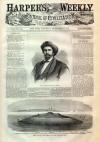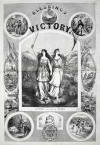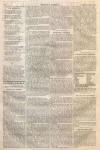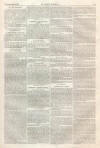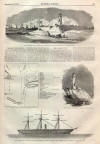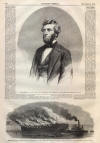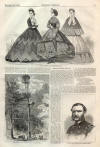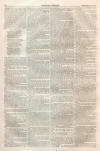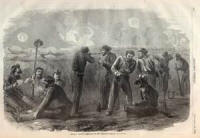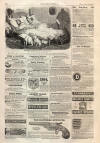John Morgan Capture and Death
|
|
This Site:
|
VOL. VIII.—No. 404.] NEW YORK, SATURDAY, SEPTEMBER 24, 1864. [SINGLE COPIES TEN CENTS. $ 4.00 PER YEAR IN ADVANCE. Entered according to Act of Congress, in the Year 1864, by Harper & Brothers, in the Clerk's Office of the District Court for the Southern District of New York. THE LATE REBEL GENERAL JOHN MORGAN.FAIRLY WON.BRAVE Sherman! here, to many a soul, Those glorious words of thine, "Atlanta's ours, and fairly won," Come like a draught of wine. The doubting spirit gains new faith, And echoes back, "Right nobly done, Atlanta's ours, and fairly won." The nation's heart beats quick to hear The double deadly blow, Striking at once the rebel armed And the secret traitor foe. Bright shines again the Northern sun, . "Atlanta's ours, and fairly won." Let this for ages be our cry, In battle or in civil strife, Whether with pen, or word, or sword, We fight the tight of life. We'll hand it down from sire to son, . "The victory's ours, and fairly won." In coming years, when smiling fields And sheaves of yellow grain, When Commerce, Arts, and Industry Surround us once again, May we proclaim with head erect, Fearful of naught, denied by none, That " Peace is ours, and fairly won." PEACE THROUGH VICTORY.Upon pages 616 and 617 we print another picture by THOMAS NAST, who drew " Compromise with the South." Like that it tells its own story—Peace comes by victory, not by submission, nor by "an immediate cessation of hostilities." The triumph of the people over their enemies is the dawn of universal peace ; the prison doors are opened and the captives go free ; they close only upon traitors who have struck at the national heart. The soldier and sailor return to the loved ones who welcome them from a field of victory and honor, not of "armistice" and armed truce ; the slave raises his head as a man; and wide-waving plenty and ripening summer overspreads the land, while in his solemn joy the patriot beholds in imagination every part of the land united, happy, and free. Our friend the artist has already shown us in all its abject woe what compromise means. He now reveals the radiant form of Peace by the steady prosecution of the war, by Victory, Union, and Liberty. The admirable picture by Mr. NAST in the Weekly of September 3 is an unanswerable argument. There will be no better in the campaign. The following stirring letter from a soldier is one expression of the universal satisfaction of loyal men with its simple truthfulness. The earnest protest of our correspondent against the craven platform at Chicago is the voice of the army. He and all his companions in arms need have no fear that their country will desert them, or believe, while a single rebel remains in the field, that " the experiment of war has failed :" HEADQUARTERS CAVALRY, WEST VIRGINIA, September, 1864. Editor Harper's Weekly!: God bless you for the high and noble patriotism and loyalty of your sheet! I can not restrain the exclamation that comes up from my heart on looking at your splendidly-designed engrav- ing in the number for September 3 of "Compromise with the South." I hope it will stir the blood of every Northern heart, as it fires that of every soldier who has fought through these terrible three years of slaughter begun by the fratricidal and murderous South. It would be impossible to depict more perfectly and feelingly what "Compromise with the South" means. Allow me to say that no one but a soldier, who has suffered and bled at the hands of these vile traitors, can fully appreciate your noble picture. It deserves to be hung in a frame of gold on the walls of every household in the North. Oh, that those cowards at the North who desire " peace at any price" could be fired with one spark of the high and self-sacrificing spirit that animates the army! We who risk most and suffer most by the war desire no peace till every black and crime-stained traitor heart is crushed in the dust, and every seed of future treason and rebellion annihilated. Accept the assurance that the army appreciates and honors you for the grand loyalty that your paper has always exhibited. Yours ever, in upholding the old flag, A SOLDIER OF THE REPUBLIC JOHN MORGAN.THE late rebel General JOHN MORGAN, the most noted guerrilla leader of this war, was a native of Kentucky. When the war broke out he was a planter with considerable means; but he left his plantation and joined the Confederate army, when he was attached to General HARDEE'S division. After the capture of Nashville by the Federals, in the spring of 1862, he was left by General JOHNSTON on the opposite side of the Cumberland, to watch the movements of BUELL's army. He did not, however. confine himself to regular operations of this nature, but gathered about him a set of adventurous young Kentuckians, whom he led in a series of predatory operations against railroads, supply-trains, and loyal citizens. In the summer of 1863 MORGAN made a raid into Ohio, which terminated in his capture. With 28 of his command he was placed in the Ohio Penitentiary. He afterward escaped by means of a tunnel, and was promoted to a brigadier-generalship. The following are the incidents of his capture and death : MORGAN was on a reconnaissance near Greenville, in East Tennessee, September 4, and was lodging at an inviting house near the village. This house happened to be the residence of Mrs. WILLIAMS, whose husband is an officer on General BURNSIDE'S staff. When MORGAN was asleep Mrs. Williams procured a horse, rode fifteen miles, and returned with a company of Union soldiers. As they arrived at the house MORGAN had just awoke. He drew his revolver and undertook to escape, when he was fired upon and killed. THE REBEL TORPEDO BOAT.WE give below a sketch of the rebel torpedo boat which was designed to do so much injury to FARRAGUT'S fleet. FARRAGUT, while outside of the Bay, was in continual expectation of' a visit from this boat, of which he had accurate information. She attempted to get out, but lost her reckoning, and the adventurers on board becoming frightened, dropped their torpedo, as it impeded their progress, and made their way back into the Bay again. After that, rough weather delayed the proposed expedition, and at last it was found that the boiler was not trust-worthy. She was sent to the city for a new one. Returning to Fort Morgan the new boiler exploded, killing the three men who managed her and sinking the vessel. The boat was made of wood, covered with sheathing of one-fourth inch iron. Her length was 38 feet, and her diameter 7 feet. The boat will be repaired for the use of the Federal fleet. Fort Morgan. Light—House. Wreck of "Philippi." Sand Island. 5 - Obstructions. A, A. Deed Light—B. Torpedo Projector.—C. Crane in elevating or lowering the Torpedo D, D. Kleets.- E. smoke stack. -.F, F. Sight holes for Pilot or Helmsman. - G. Covering of Steam-drum. REBEL TORPEDO BOAT.--[DRAWN BY R. WIER, UNITED STATES NAVY.] 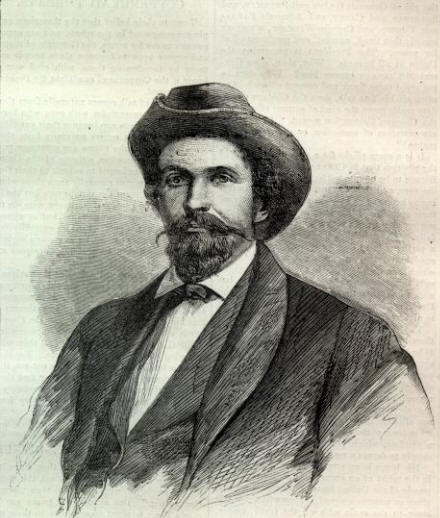 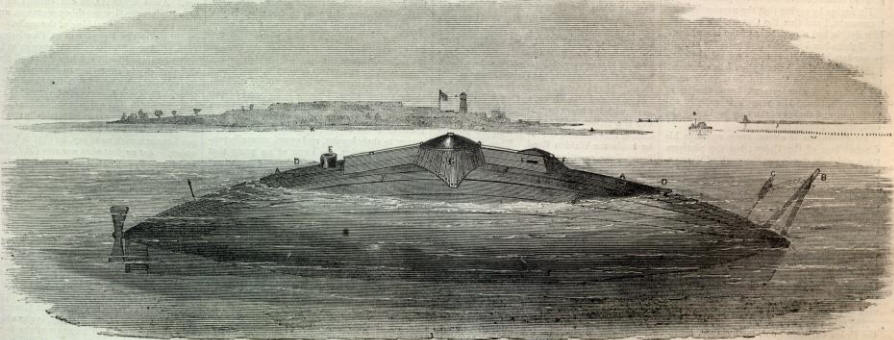
We acquired this leaf for the purpose of digitally preserving it for your research and enjoyment. If you would like to acquire the original 140+ year old Harper's Weekly leaf we used to create this page, it is available for a price of $195. Your purchase allows us to continue to archive more original material. For more information, contact paul@sonofthesouth.net |
||||||||||||||||||||||
|
|
||
|
|
Site Copyright 2003-2018 Son of the South. For Questions or comments about this collection, contact paul@sonofthesouth.net |
|
|
Are you Scared and Confused? Read My Snake Story, a story of hope and encouragement, to help you face your fears. |
||
